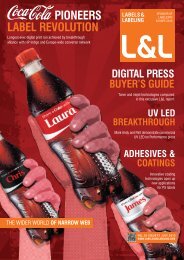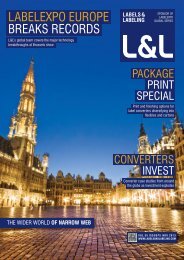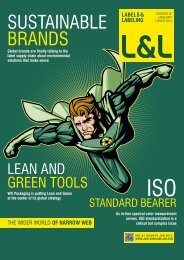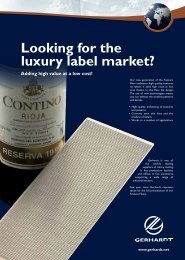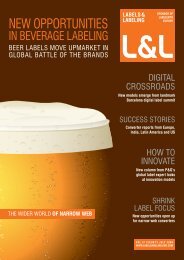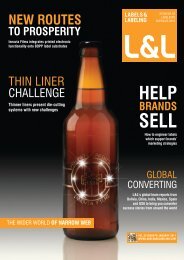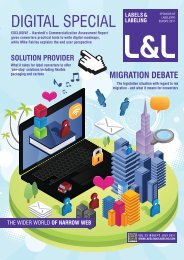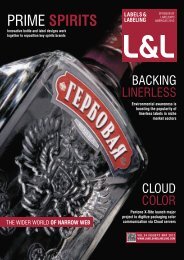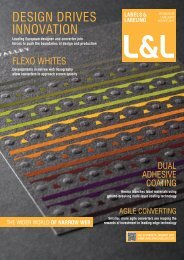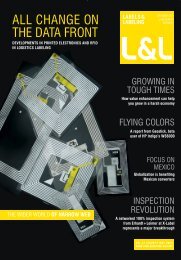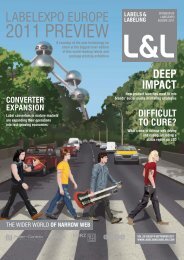Create successful ePaper yourself
Turn your PDF publications into a flip-book with our unique Google optimized e-Paper software.
78 | L&L<br />
Qreate<br />
JOHN FOLEY JR, CEO of<br />
Interlink1 and GrowSocially, looks<br />
at profitable ways of incorporating<br />
QR codes into your client’s printing<br />
initiatives<br />
In order to sell a QR code effort, you<br />
may first need to convince clients of the<br />
possible benefits it could offer them.<br />
Consumers look to the label to provide<br />
additional information such as nutritional<br />
listings, ingredients, and recipes. While<br />
you may be able to fit some of that<br />
information on the label, space is limited.<br />
Your client may not want to invest in an<br />
extended content booklet, or a peel and<br />
reveal label. When those situations arise,<br />
a QR code could be the perfect answer. It<br />
could easily direct the consumer to more<br />
information on their smartphone.<br />
That leads us into another selling<br />
point for QR codes. The growing mobile<br />
audience means there’s a very good<br />
chance the majority of your potential<br />
consumers have a device that will allow<br />
them to engage with you via QR codes.<br />
MORE VALUE:<br />
BUILDING MOBILE WEBSITES<br />
While a QR code can incorporate a<br />
large amount of data – up to 4,000<br />
alpha-numeric characters – it doesn’t<br />
mean that it should. QR codes work<br />
best when they direct people to<br />
mobile-websites that provide additional<br />
relevant information.<br />
This is where I think that printers have a<br />
tremendous opportunity to make money.<br />
Marketers everywhere are hearing the<br />
buzz that mobile is hot. They need to<br />
create mobile-optimized online content<br />
as quickly as possible. And that is where<br />
they need a converter’s assistance.<br />
In addition to selling the QR code,<br />
conerters have the opportunity to sell<br />
them the mobile website that will provide<br />
consumers with more information about<br />
their product.<br />
The mobile website can contain text,<br />
images, videos, links to social networking<br />
profiles, and more. It also could contain<br />
a form that allows consumers to request<br />
more information about the product,<br />
or simply sign up for the company’s<br />
newsletter.<br />
LABELS&LABELING<br />
SALES EXAMPLES<br />
Here are five value-added examples<br />
where you could offer QR codes and<br />
mobile websites to your clients:<br />
FOOD<br />
If the client’s product is a pasta sauce,<br />
the code could direct people to a site<br />
that lists recipes and food pairings. The<br />
site could also offer links to the client’s<br />
social networks, online storefront, and<br />
newsworthy stories.<br />
AFTERMARKET AUTO<br />
PERFORMANCE<br />
The QR code could direct people<br />
to a video of a car that had that part<br />
installed. When a consumer scanned<br />
the code at the parts store, they would<br />
immediately see how the part performs,<br />
read client reviews, or browse through<br />
technical specifications.<br />
Aftermarket parts manufacturers<br />
could also utilize a QR code during the<br />
installation process, directing people<br />
to videos of installation tips.<br />
WINE<br />
This is a great opportunity for<br />
something that I call a ‘Shelf Talker’.<br />
This is a tag that would be slipped<br />
over the neck of the bottle. The tag<br />
would have a QR code printed on it that<br />
would direct the consumers to a mobile<br />
website. The winery could use the<br />
mobile website to tell the story of their<br />
winery/vineyard. It could contain text,<br />
pictures, and videos.<br />
Not only can the ‘Shelf Talker’ create<br />
attention for the wine bottle, it also can<br />
connect the consumer directly with the<br />
folks behind the wine.<br />
COUPONS<br />
In many cases a coupon label is an<br />
instant redeemable coupon (IRC)<br />
that the consumer can remove after<br />
purchase. Your clients more than likely<br />
have you print a 1D barcode that could<br />
be used at a point of purchase.<br />
If a QR code was used in place of the<br />
1D code, the consumer would be able<br />
to scan the code and be directed to a<br />
mobile website. There, they could make<br />
a purchase, redeem a rebate, sign up<br />
for a mailing list, or maybe even watch<br />
a video.<br />
REPORTING<br />
Not only do QR codes enable<br />
converters to tell a client how many<br />
people are scanning them, they’re able<br />
to give them feedback on the general<br />
location of the scan and the date and<br />
time most scans are occurring. This<br />
is important because it lets your client<br />
know when and where their product<br />
is being reviewed and hopefully<br />
purchased.<br />
Go to http://<br />
QReateAndTrack.com<br />
for more information on<br />
QR codes.



